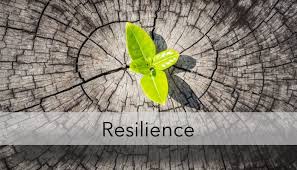There’s nothing like a crisis to get us in touch with our capacity for resilience. Faced with challenges and unexpected events, we come to realized where our strength lies. We get to see how well we can bounce back from what has knocked us flat.
How would you rate your bounce-back-ability? When life hits you hard and you find yourself on your knees, how quick are you to stand back up?
It can be tempting to stay down there, face buried in the dirt, hands over our heads, wishing it would all go away. And sometimes, that might be just what we need. Some blows in life require a withdrawal from all that was previously considered “normal” long enough for the weight of what has happened to settle in on a level that you can get in touch with. Sometimes, we just need to catch our breath.
After the surrender, what’s next?
Resilience is where our hope lives even when we can’t necessarily feel it. It is where courage has its roots ~ where we have that sense that we are grounded in something that will sustain us as we take our next steps into the unknown. All the resources that have the potential to support us in the process are stored in the chest of resilience just waiting for us to call it all forth. The very essence of our desire to re-engage in life is at the heart of resilience. It moves us beyond our capacity to survive and straight into our divine right to thrive.
So, what’s the catch?
Recognizing capacity for resilience usually involves facing adversity. We have to come in contact with what knocks us down before we can bounce back from it. With each troubled waters we are required to cross, we are given the opportunity to deepen our resilience. We get to see how well the tools we developed “last time” serve us now.
As someone who has chosen a Vocation of Service, it is part of your role to assist others as they connect to their personal sense of resiliency. You will be a much more efficient navigator in this process if you have discovered your own personal source of resilience along the way.
Feeling Resilient
This global pandemic provides an opportunity to build our resilience and as Service Providers walk the talk as we respond to the needs of others. It also gives us the chance to tune in and feel our resilience. Quite often it is not until after the storm passes that we realize we acted out of resilience at all. In the grips of an emergent situation, we can often feel further away from resilience and in fact feel like we are on the brink of collapse. Resilience lies just beneath.
One micro-step you can take is to tune into the sensory experience of resilience. What does resilience feel like? Begin your day by bringing your awareness to the energetic presence of resilience. Once you have identified what it feels like for you, it will be much easier to recognize its presence in the moment.
A Strategy for Resilience
Recently, I was speaking with Dr. Jenny Cundari, ND currently practicing in the San Francisco area and also remotely. Dr. Cundari suggested making two lists for those times when I experienced any sense of overwhelm. Two lists and a commitment ~ that’s the essential piece.
The first list ~ we’ll call it the “yes list” ~ captures all those actions you will take in the moment at the first signs of overwhelm or stress. Any emotion that you would normally run from can be the impetus to choose one of these strategies. The “yes list” might go a bit like this:
When I am overwhelmed I choose to…
- Go for a walk
- Stop and focus on breathing for 5 minutes
- Take a nap
- Grab a cup of tea or glass of water
- Journal
It’s good to have variety so you can choose something that fits with your current environment, time availability, and mood.
The second list ~ we’ll call this one the “no list” ~ well, it’s the one that describes all the habits and coping strategies that you are used to turning to and that you know don’t really help. These are the things outside of ourselves that we grab in the moment because they are a quick fix ~ or maybe, better said ~ a quick, temporary fix, often leaving us feeling worse than before. Your “no list” may sound like this:
When I am feeling overwhelmed, I choose not to…
- Complain and make up stories based on my frustrations
- Binge on Netflix
- Eat a big bag of chips with a side of chocolate
- Grab a “glass” of wine that becomes the whole bottle
- Mindlessly scroll social media
You know what your “vices” are ~ it will be the first few things that pop into your head when you start this list. Remember, it’s for your eyes only and it’s within your power to alter and refine both lists as you see fit. Be honest and be gentle. If there’s anything that supports the development of resilience it is self-compassion.
Now it’s time to make that commitment I mentioned earlier. Take a deep breath, read through your lists and honestly decide what you can and cannot follow through with at this time. The last thing you want to do is set yourself up for failure.
Make your commitment when you are ready, knowing that commitments can always be re-negotiated if you find something doesn’t work for you.
I made my lists in about 5 minutes. I shared this exercise with my good friend and writing buddy and she created her own. We borrowed from each other’s ideas and agreed to be sources of support reminding each other to go to our lists when we had forgotten.
Gwen Bevan, MSW, RSW, a Vancouver-based counsellor, expands on this idea to include a third list ~ we’ll call this one the “foundations list.” It is here that you will capture those strategies that are a must when it comes to your health and wellness on a daily basis. These are things you know you need in order to feel your best and function optimally.
These strategies create the space for you to feel safe and supported in the midst of overwhelm, but also so you can feel and experience joy and fulfillment as a norm in daily life. This foundation makes it possible for you to even consider your “yes list” when stress levels spike and emotions take over. Your “foundations list” is the space where you demonstrate self-love which makes way for self-compassion. And you know what that does for your sense of resilience.
Your “foundations list” might go like this:
Because how I feel emotionally and physically matters to me, these are the things I must include in my routine:
- Daily walks
- 3 face time sessions with people I love
- Healthy food that tastes good
- 7 hours sleep
- At least 1 good belly laugh a day
As healthcare and human service providers, first responders, and personal caregivers, there is a unique opportunity at this time to strengthen your stores of resilience, to practice what will be of benefit to your wellbeing now and in the future, and to identify the resources around you that make it possible to care for yourself ~ not only so you can do and give more to others ~ but so you can expand your ability to receive and know fulfillment through your service.
Another instalment in the Conscious Service Series for Helping Professionals and Personal Caregivers.


